Reproduction in Plants and Animals
REPRODUCTION IN PLANTS AND ANIMALS
Introduction
- The process by which mature individuals produce offspring.
- Reproduction is an essential characteristic of all living organisms.
- There are two types of reproduction: sexual and asexual
Sexual reproduction involves the fusion of male and female gametes to form a zygote. The fusion of the nuclei of male and female gametes is known as fertilization. Asexual reproduction does not involve gametes, instead parts of a mature organism may develop to new individuals.
Importance of reproduction
- Procreation - reproduction sustains the species so that it does not become extinct.
- Quality improvement- it allows for the mixing of genetic materials leading to variation among individuals in a species. This is seen in sexual reproduction. The variations form basis of adaptability in their habitats.
CELL DIVISION
Cell division starts with division of nucleus i.e. the chromosome then the cytoplasm. In unicellular organisms the cell divides into two separate daughter cells while in multicellular ones the cell divides into two and continues to divide in the same way.
Chromosomes
- In the nucleus are a number of thread-like structures called chromosomes. Each cell has fixed number of chromosomes.
- Each chromosome is made up of two parallel strands called chromatids each pair of chromatid is connected atone point by a structure called centromere.
- Chromosomes are present in the nucleus all the time, but only become visible when viewed under a microscope during cell division.
- Chromosomes occur in pairs in the body cells and each pair has a characteristic length. The member of each pair is called a homologous chromosome. This means that they look alike in appearance although their genetic composition may be different.
- Along the length of the chromosomes is a series of structures called genes. They are too small to be seen even under a powerful microscope. Genes determine the characteristics of the cell and its progeny.
- Genes are made up of a protein chemical substance called DNA (Deoxyribonucleic acid) which contain coded information of instructions that dictate the characteristics of the offspring.
The sequence of events leading to cell division in plants and animals is basically the same.
There are two types of cell division namely mitosis and meiosis.
Mitosis
- This is a type of cell division in which a cell divides into two daughter cells each having the same numberof chromosomes as the parent cell.
- This takes place in all body(somatic) cells of an organism to bring about increase in number of cells, resulting in growth and repair.
- Mitosis is usually described as a series of stages for convenience of explaining the process involvrd in a logical manner. These stages are, Interphase, Prophase, Metaphase, Anaphase and Telophase.
- These stages of cell division occur in a smooth and continuous pattern so that one stage merges with the next without interfering with the activities of the cell.
Interphase
The term interphase is used to describe the state of the nucleus when the cell is just about to divide.
During this time the following take place:
- Multiplication of genetic material so that daughter cells will have the same number of chromosomes as the parent cell.
- Manufacture of cell organelles such as mitochondria, golgi bodies, centrioles, ribosomes and centrioles.
- Energy for cell division is synthesised and stored in form of Adenosine Triphosphate (ATP) to drive the cell through the entire process.
During interphase, the following observations can be made:
- Chromosomes are seen as long, thin, coiled thread-like structures.
- Nuclear membrane and nucleolus are intact.

Prophase
- The chromosomes shorten and thicken.
- Each chromosome is seen to consist of a pair of chromatids joined at a point called centromere.
- Centrioles (in animal cells) separate and move to opposite poles of the cell.
- The centre of the nucleus is referred to as the equator.
- Spindle fibres begin to form, and connect the centriole pairs to the opposite poles.
- The nucleolus and nuclear membrane disintegrate and disappear.

Metaphase
- The nuclear membrane disappears hence chromosomes are free in the cytoplasm.
- The spindle fibres lengthen. In animal cells they attach to the centrioles at both pole
- Each chromosome moves to the equatorial plane and is attached to the spindle fibres by the centromeres.
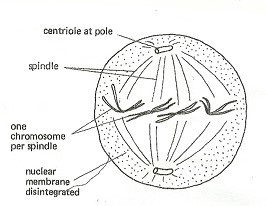
Anaphase
The following events occur during this phase,
- Chromatids separate and migrate to the opposite poles due to the shortening of spindle fibres .
- Thespindleapparatusbegins to disappear.
- In animal cells, the cell membrane starts to constrict towards the end of the anaphase.

Telophase
This is the final phase ofcell division
- The chromatids collect together at the two opposite ends of the spindle.
- A nuclear membrane forms around each set of chromatids andare nowreferred to as chromosomes.
- The cytoplasm divides into two leading to the formation of two daughter cells.
- Chromosomes later become less distinct.
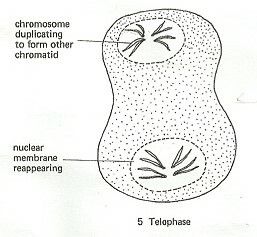
Significance of Mitosis
- It brings about the growth of an organism:
- It is a basis of asexual reproduction.
- Ensures that the chromosome number is retained.
- Ensures that the chromosomal constitution of the offspring is the same as the parents.
Meiosis
• The mother cell has the diploid number of chromosomes.
• The four cells (gametes) have half the number of chromosomes (haploid) that the mother cell had.
• In the first meiotic division there is a reduction in the chromosome number because homologous chromosomes and not chromatids separate.
• Each division has four stages; Prophase, Metaphase, Anaphase and Telophase.
• This type of cell division takes place in reproductive organs (gonads) to produce gametes.
• The number of chromosomes in the gamete is half that in the mother cell
Interphase
• As in mitosis the cell prepares for division.
• This involves replication of chromosomes, organelles and builds up of energy to be used during the meiotic division.

First Meiotic division
Prophase I
• Homologous chromosomes lie side by side in the process of synapsis forming pairs called bivalents.
• Chromosomes shorten and thicken hence become more visible.
• Chromosomes may become coiled around each other and the chromatids may remain in contact at points called chiasmata (singular chiasma).
• Chromatids cross-over at the chiasmata exchanging chromatid portions. Important genetic changes usually result.

Metaphase I
• Spindle fibres are fully formed and attached to the centromeres.
• The bivalents move to the equator of the spindles.

Anaphase I
• Homologous chromosomes separate and migrate to opposite poles.
• This is brought about by shortening of spindle fibres hence pulling the chromosomes.
• The number of chromosomes at each pole is half the number in the mother cell.

Telophase I
• Cytoplasm divides to separate the two daughter cells.

Second Meiotic Division
• Usually the two daughter cells go into a short resting stage (interphase)
• But sometimes the chromosomes remain condensed and the daughter cells go straight into metaphase of second meiotic division.
• The second meiotic division takes place just like mitosis.
Prophase II
• Each chromosome is seen as a pair of chromatids.

Metaphase II
• Spindle forms and are attached to the chromatids at the centromeres.
• Chromatids move to the equator.

Anaphase II
• Sister chromatids separate from each other
• Then move to opposite poles, pulled by the shortening of the spindle fibres.

Telophase II
• The spindle apparatus disappears.
• The nucleolus reappears and nuclear membrane is formed around each set of chromatids.
• The chromatids become chromosomes.
• Cytoplasm divides and four daughter cells are formed.
• Each has a haploid number of chromosomes.

Significance of Meiosis
• Meiosis brings about formation of gametes that contain half the number of chromosomes as the parent cells.
• It helps to restore the diploid chromosomal constitution in a species at fertilisation.
• It brings about new gene combinations that lead to genetic variation in the offsprings.
The differences between mitosis and meiosis
| Mitosis | Meiosis |
| • Maintenance of chromosome number (diploid) | • Reduction/halving of chromosomes (haploid) |
| • Takes place in somatic cells/growth | • Occurs in reproductive cells/gonads/produces gametes |
| • No crossing over/no variations | • Crossing over takes place/variation occurs |
| • Results into 2 daughter cells | • Results into 4 daughter cells |
| • No pairing/no synapsis/no bivalent formed | • There is paring/synapsis/bivalent |
| • A one division process of four stages | • A two division process of four stages each |
Similarities between mitosis and meiosis
• Both take part in cells
• Both involve division of ceels (cell multiplication)
Asexual Reproduction
• Formation of new organisms without fusion of gametes
• Occurs with only one parent
• Parts of organism develop into new individual
Advantages of asexual reproduction
• Retention of useful characteristics/genes/traits
• Offspring establish faster/shorter life cycle
• Better chances of survival because of suitable environment
Disadvantages of asexual reproduction
• Lack of genetic variation
• Lowered resistance to disease
• Loss of hybrid vigor
• Competition for resources due to overcrowding
Types of asexual reproduction
1.Sporulation
• Formation of spores
• Spores are small haploid cells produced by plants
• Spores give rise to new haploid organisms
• Includes moulds, ferns, bryophytes, pteridophytes
2.Budding
• Where an outgrowth arises from a parent and drops off to develop into a new organisms
• Hereditary material in the daughter cell and parent are exactly the same
• Occurs in organisms such as hydra, jelly fish, sea anemones, yeast and some fungi.

3.Binary fission
• A cell splits into two new cells of equal size
• Each daughter cell grows into anew organism
• Occurs in organisms such as amoeba, euglena, paramecium, some fungi and bacteria.

Sexual Reproduction in plants
Structure and Functions of parts of a flower
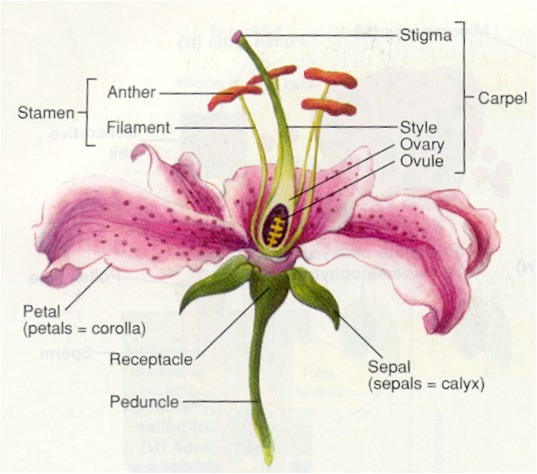
Receptacle
• expanded end of stalk which bears floral parts
Calyx
• consists of sepals
• usually green
• protect flower in bud
Corolla
• consist of petals
• often colored or scented to attract insects
Androecium
• male part of flower
• consist of stamens
• each stamen consists of an anther containing pollen sacs
• anther produces pollen grains which contain male gametes
Gynaecium
• female part of flower
• consists of one or more carpels
• each carpel contains one or more ovules in an ovary
• style bearing a stigma extends from ovary
• ovary contains female gametes which when fertilized become seeds
The meaning of the following terms which describe flowers
Hermaphrodite(Bisexual)
• One with both stamen and carpel eg Hibiscus
• Most flowers are hermaphrodite/bisexual
Unisexual
• Have only one of the reproductive organ: carpel or stamen i.e. either male or female flower.
Carpelate
• Also called pistilate
• contains only carpels hence a female flower
Staminate
• Also called a male flower.
• Contains stamens only.
Dioecious plants
• Have pistilate and staminate flowers on different plants e.g. pawpaw
The plants are also known as male or female plant.
Monoecius plants
• Have pistilate and staminate on one plant
• However, pistilate and staminate occur at different parts of the plants e.g. maize
Complete flower
• Has all four parts i.e. Calyx, corolla, androecium and gynoecium
Incomplete flower
• Do not have all four parts
• At least one part is missing.
Regular flower
Those that can be divided into two similar halves by any vertical section passing through the centre. this types of flowers are radially symmetrical.
Irregular flower
Can be divided into two equal halves in one particular plane only. such flowers are bilaterrally symmetrical.
Pedicillate flower
Flower with a stalk.
Solitary flower
Those that occur singly while those that grow in cluster make an inflorescence.
Types of ovary
Superior
• ovary occurs above other floral parts on the receptacle.

Inferior (epigynous)
• other floral parts arise above ovary on the receptacle.

Pollination
• Transfer of pollen grains from anther to stigma of a flower
Types of pollination
• Self pollination takes place when mature pollen grains of a flower fall on the stigma of the same flower
• Cross pollination takes place when pollen grains of a flower fall on the stigma of another flower of the same species
Advantages of pollination
• Healthy offspring
• Leads to variation
• Greater chances of dispersal
Agents of pollination
• Wind
• Insects
Adaptations of flowers to wind and insect pollination
Insect pollinated flowers (entomophilus)
• Are scented to attract insects
• Have stick stigma for pollen grains to stick on
• Are brightly coloured to attract insects
• Presence of nectar to attract insects
• Have nectar guides to guide insects to the nectarines
• Have nectarines to secrete nectar
• Stigma/ anthers located inside the flower/tubal/funnel shaped corolla to increase chances of contact by insects
• Sticky/spiny/spiky pollen grains which stick on the body of insects and on stigma
• Large/conspicuous flowers easily seen by/attract insects
• Anthers firmly attached to the filament for insects to brush against them
• Landing platform to ensure contact with anthers and stigma
• Mimicry to attract (male) insects.

Wind pollinated flower (anemophilus)
• Anthers/stigma hang outside the flower to increase chances of pollination
• The style/filament is long to expose stigma/anthers
• Stigma is hairy/feathery/branched to increase surface area over which pollen grains land/to trap pollen grains
• Pollen grains are smooth/dry/light/small to be easily carried by wind
• Large amount of pollen grains to increase chances of pollination
• Anthers loosely attached to filaments to enable them to sway to release pollen grains
• Pollen grains may have structures which contain air to increase buoyancy
• Flowers have long stalks holding them out in the wind
Ways in which plants prevent(Hinder) self-pollination
• Protandry(anthers/stamens mature first)
• Protagyny (pistils mature first)
• Monoecism (where male and female parts are on same plant but different parts)
• Dioecism(where male and female parts are on different plants)
• Incompatibility (self sterility)
• Heterostyly (styles at different heights)
Characteristics that ensure cross pollination takes place in flowering plants
• Presence of special structures that attract agents of pollination
• Protandry/dichogamy
• Protagyny/dichogamy
• Monoecism
• Self sterility
• Heterostyly
Advantages of cross pollination
• hybrid vigour
• less prone to diseases
• promotes genetic variation
• greater evolutionary potential
Fertilization
- Fusion of male and female gametes to form a zygote
How does fertilization takes place in a flower
• This follows pollination
• Pollen grain is deposited on the stigma
• Pollen grain sticks to the surface of the stigma
• The surface of the stigma produces a chemical substance which stimulates the pollen grain to produce a pollen tube/to germinate
• The pollen tube grows through the style tissues on which it feeds until it enters the ovary
• The generative nucleus divides into two giving two male nuclei
• Embryo sac contains eight nuclei i.e. two synergids, egg cell, two polar nuclei and three antipodal cells
• The pollen tube enters the embryo sac through the micropyle and one of the male nucleus fuses with the egg cell/ovum to form a zygote
• The other male nucleus fuses with the two polar nuclei to form the triploid nuclei/endosperm)food storage used by developing embryo)
• The pollen tube nucleus in the pollen tube disintergrates soon afterwards
• This process is referred to as double fertilization
• Zygote grows into an embryo containing plumule, radicle and cotyledons
What is double fertilization?
• This is where two male nuclei enters the embryo sac.
• One fuses with the ovum to form a zygote, while the other fuses with the polar nuclei to form a triploid primary endosperm nucleus.
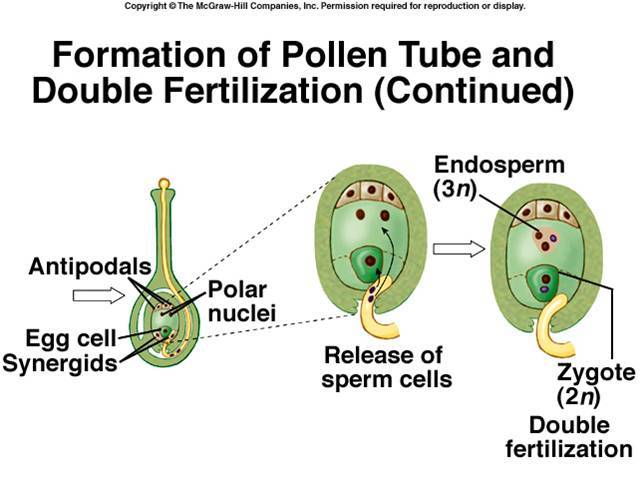
• Therefore there are two fusions at fertilization Hence Double Fertilization.

Changes that Occur in a flower after fertilization
• Petals, stamen, calyx and style wither
• Ovary wall changes into pericarp
• Intergument changes into seed coat/testa
• Zygote changes into embryo (by mitosis)
• Primary endosperm nucleus changes into endosperm
• Whole ovule changes into seed
• Ovary develops and grows into fruit(under the influence of gibberrellic hormone)
Fruit formation
• One of the organs that remains on the plant after pollination and fertilization is the ovary
• Within the ovary, the developing embryo produces special chemical substances that stimulate the young ovary
• These substances also signal the start of the formation of the fruit, which is a mature ovary
• The fruit may contain one or more seeds
• During fruit formation the ovary increases in size while ripening or maturing
• A true fruit is formed from the ovary of a flower after fertilization
• It has two scars(style scar and stalk scar) and contains seeds
• Some seeds are not formed from the ovary of a flower
• Some other parts of a flower develop to form a fruit
• Such fruits are called false fruits
How are fruits grouped?
Simple fruits
• formed from a single flower or one ovary e.g. mango
Aggregate fruits
• consists a group of ovaries that appear on a common receptacle e.g. strawberry
Multiple (compound) fruits
• formed from several flowers whose ovaries fuse together after fertilization
• form a bunch e.g. pineapple, figs
• are always false fruits
What are succulent fruits?
• also called fleshy fruits
• all or part of pericarp (fruit wall) becomes juicy
Types of juicy fruits
-Berry
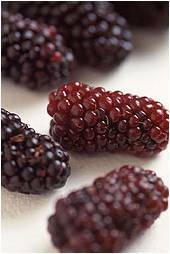
• has many seeds
• whole pericarp is succulent e.g. orange, tomato, pawpaw
Drupe
• only one seed
• pericarp divided into three layers i.e. epicarp, mesocarp(juicy) and endocarp(hard)
• e.g. mango and coconut
Pome
• juicy part is swollen receptacle
• is usually a false fruit
• example is a pear

What are dry fruits?
• have a pericarp that is dry, hard and woody
• either dehiscent or indehiscent
• called dry because they are not succulent
What are dehiscent fruits?
• split open when ripe to release seeds
• contain many seeds
Give types of dehiscent fruits
Legumes
• split along two edges
• are usually pods e.g. beans, peas, crotolaria
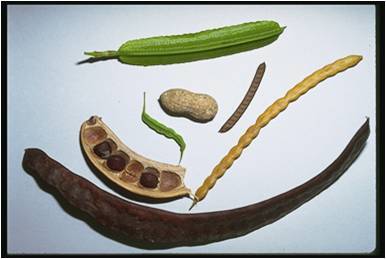
Follicle
• split on one side only e.g. Sodom apple
Capsule
• has several lines of weakness/sutures
• open in many places e.g. castor oil, cotton
What are indehiscent fruits?
• non-splitting fruits
• usually one seeded only
Give main types of indehiscent fruits
Nut
• pericarp woody, hard and thick e.g. cashew
Achene
• has thin, tough pericarp e.g. sunflower
Placentation
• arrangement of ovules within the plant ovary
Types of placentation
Marginal
• placenta appears as one ridge on ovary wall
• ovules are attached to placenta in rows e.g. peas in a pod
Basal
• placenta formed at the base of the ovary with numerous ovules attached to it.
Parietal
• edges of carpels fuse together
• dividing walls disappear, leaving one loculus
• have numerous seeds e.g. passion fruit
• placenta of each carpel appears as ridges on ovary wall
Axile
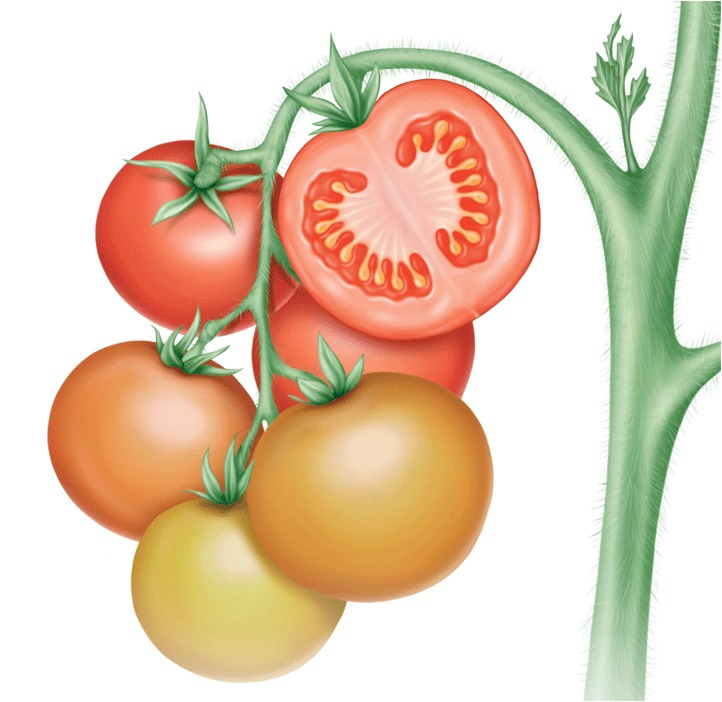
• edges of carpels fuse together to form a single central placenta
• numerous ovules arranged on placenta
• ovary divided into a number of loculi by walls of the carpel e.g.
Free central placentation
• edges of carpels fuse together
• dividing was disappears leaving one loculus
• placenta appears at base of ovary
• has numerous ovules
Importance of fruits in the survival of plants
• Protect the seed against dessication, predators and adverse conditions
• Aid in seed dispersal by attracting agents of dispersal
• Stores food for the plant
Differences between parthenogenesis and parthenocarpy
• Parthenogenesis is development of new animals from unfertilized eggs
• Parthenocarpy is development of a fruit without fertilization
How is a seed formed?
• After fertilization, zygote grows into an embryo, primary endosperm nucleus developed into endosperm, interguments harden to form testa, hence the whole ovule becomes the seed
• the seed loses water to become drier
• the seed has plumule, radicle, seed leaves called cotyledons, a microphyle and a scar
iii) A diagram of a seed
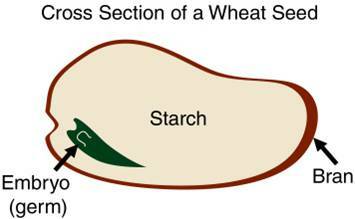
The main parts of a seed
Testa
• also called seed coat
• a tough outer covering which protects the seed from insects, bacteria etc
• segment is the membrane inside the testa
Hilum
• a scar
• spot where the seed was attached to the fruit or pod
Micropyle
• small hole through which water and air enter the seed
Radicle
• embryonic root
• grows into the shoot system
Cotyledons
• embryonic leaves
• store food for the germinating seed i.e. for plumule and radicle
• when plumule and radicle grow, they use food stored in the cotyledon
• in some seeds food is stored in the endosperm
The differences between a seed and fruit
| Seed | Fruit |
| • fertilized ovule | • fertilized ovary |
| • attached to placenta through funicle | • attached to branch through a stalk |
| • one scar called hilum | • two scars (style scar and stalk scar) |
| • has seed coat/testa | • has fruit wall/pericarp |
| • seed wall undifferentiated | • fruit wall is differentiated |
Fruit dispersal
• Spreading of seeds and fruits away from parents so as to settle where conditions are suitable for their germination
Nessesity of seeds and fruits dispersal
• prevent overcrowding
• reduces competition for space, nutrients and light
• colonization of new areas is made possible
• to increase chances of survival
• to prevent inbreeding
• to avoid extinction due to over competition for the necessities
Adaptations of seeds and fruits to various methods of dispersal
Adaptations for wind dispersal
• they have wings, feathers or hair-like structures to increase surface area for wind to carry them easily/buoyancy
• seeds/fruits are loosely attached on the stalks so that they can easily be released and carried away by wing
• seeds/fruits are generally light and small sized to be easily carried by wind
• some seeds/fruits have parachute-like structures to be easily carried b wind
• some have censor mechanism where seeds and fruits are borne on long stalks that are loosely attached which allows swaying so that movements of capsule by wind releases the seeds
Water dispersal seeds
• seed/ mesocarp has air spaces thus light/buoyant to float hence carried by water
• they have waterproof cover and tough pericarp protects seeds from getting soaked
• fibrous and spongy mesocarp to easily float
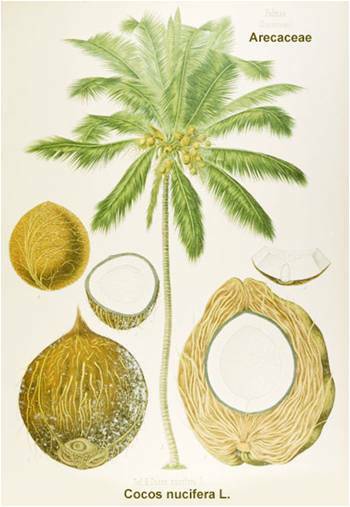
Animal dispersal seeds
• presence of hooks for attachment to animals thus carried to other parts
• fruits are brightly coloured, succulent and scented to attract animals
• seed coats are hard and resistant to digestive enzymes hence seeds are dropped away from mother plant
• large in size or borne on clusters to be easily seen.


Self dispersal/explosive
• self opening seeds
• they have lines of weakness called sutures for violent opening thus scattering seeds away from parent plant
Sexual Reproduction in animals
• Special organs known as gonads produce gametes.
• In males testes produce sperms while in females ovaries produce ova.
• The fusion of male gamete and female gamete to form a zygote is called fertilisation.
There are two types of fertilisation. External and internal
Distinguish between external and internal fertilization in animals
• In external fertilization fusion of the male and female gametes takes place outside the body of the female e.g. amphibians and fish
• In internal fertilization union of gametes occurs inside the body of the female
State the advantages and disadvantages of external fertilization
Advantages
• Large numbers produced therefore many offspring per breeding season
• Female does not suffer gestation stress
• Mother does not need to care for the young except in a few species
• The surviving individuals are highly selected for better survival
Disadvantages
• many predators surround the eggs before and after fertilization
• fewer chances of fertilization/a lot of gametes wasted
• embryo development at mercy of environment
• large numbers of female gametes are required therefore female gets much exhausted
State the advantages and disadvantages of internal fertilization
Disadvantages
• number of gametes fewer hence less number of offspring
• less adapted for sudden change of environment after birth
• in mammals females suffer gestation stress
Advantages
• more chances of fertilization
• fewer predators of oval/fertilized egg protected in females body
• stable internal environment
• fewer gametes required
Give a reason why it is necessary for frogs to lay many eggs
• to increase chances of survival/fertilization
Compare external and internal fertilization
| External fertilization | Internal fertilization |
| occurs in water outside the bodies of animals | occurs inside the body of the female animal |
| many eggs are laid | fewer eggs released from ovary |
| usually less contact between male and female | very close contact in form of copulation between male and female |
| both fertilized eggs exposed to danger | Fertilized eggs are enclosed hence highly protected inside females’ body. |
Reproduction in mammals
The egg laying mammals (MONOTREMES) Are said to be oviparous. An example of an oviparous mammal is the platypus.
In some mammals, the zygote does not develop fully within the uterus but completes development within a special structure called pouch as in the marsupials eg kangaroo.
In most mammals however, the zygote develops fully into a young mammal which resembles that adult.
The ability to give birth to young as in placental mammals is referred to as Viviparity. mammals whose zygotes develop within the uterus have mammary glands. The glands produce milk on which the young ones feed on until they are able to feed on the same food as adults. In these mammals, parental care is highly developed.
Reproduction in Human Beings
Structure of female reproduction system

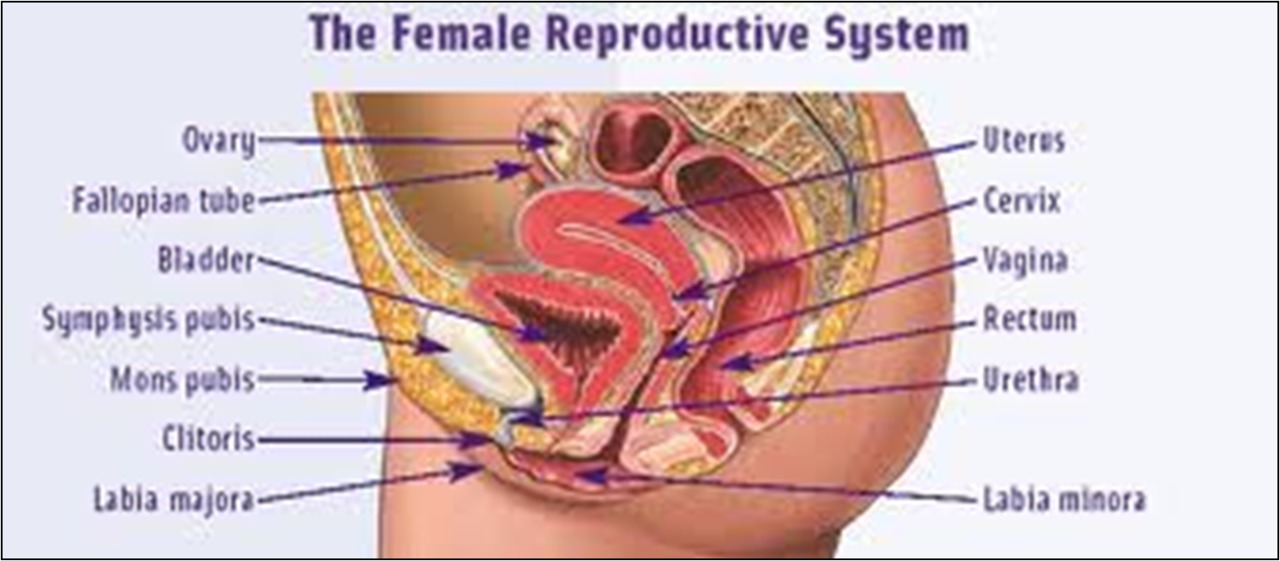
The female reproduction system consists of the following:
1. Ovaries
• Are two oval cream coloured structures found in lower abdomen below the kidneys.
• have several graafian follicles that develop and burst open to release/produce mature ova
• secretes sex hormones)oestrogen) which initiate/control development of secondary sexual characteristics
• produce hormones oestrogen and progesterone which prepare the uterus for implantation and subsequent nourishment of the embryo.
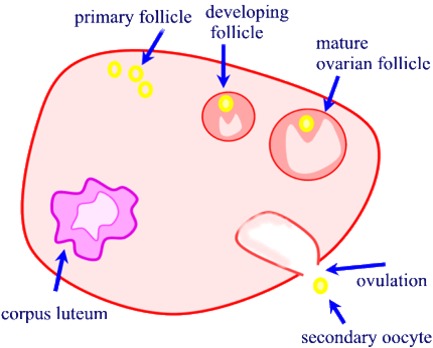
Adaptations of the ovum to its function
• nucleus contains genetic material
• ventelline membrane encloses plasma membrane which encloses yolky cytoplasm
• yolky cytoplasm provides nourishment
• jelly coat protects ovum against dehydration
2. Oviducts(fallopian tube)
• Are tubes which conduct the ova produced by the ovaries to the uterus.
• Fertilisation occurs in the upper part of the oviduct.
• are thin narrow and tubular to increase flowing speed of semen containing sperms
• are funnel shaped on the end next to ovary which enables them to receive the ovum
• their lining contains cilia which propel the ovum towards the uterus
• has peristaltic muscles that enable movement of zygote/ovum to the uterus for implantation
• is fairly long to increase surface area for fertilization
3. Uterus
• The uterus is a hollow muscular organ found in the lower abdomen.
• The embryo develops inside the uterus.
• The inner lining endometrium supplies nutrients to embryo.
• The embryo is implanted into the inner uterine wall- the endometrium which nourishes the embryo.
• The thick muscles of the uterus assist in parturition.
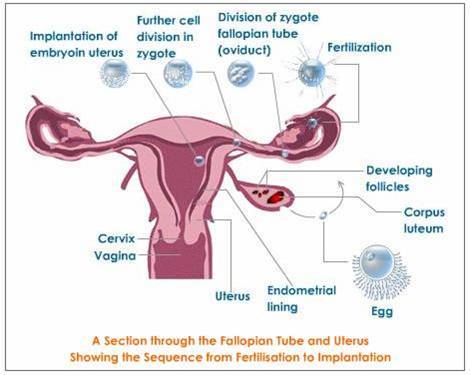
4. Cervix
• Has a ring of muscles that separates the uterus from the vagina.
• It forms the opening to the uterus
• has valves that close the lower end of the uterus to ensure continued pregnancy during gestation period
is capable of dilating
• has narrow entrance/neck-like entrance to uterus that enables quick swimming of sperms to uterus
• has suction mechanism that draws up/pulls sperms into uterus
• has a “W” shape that fits well with the glands of the penis to ensure sperms are deposited at the right point
5. Vagina
• Is a tube that opens to the outside and it acts as the copulatory and birth canal through the vulva.
• it is elastic and muscular to enable good accommodation or penetration of the penis thus proper deposition of sperms and for easy parturition
• allows menstrual flow
• has sensitive labial walls which secrete/produce lubricating substances that ensure/enable/facilitate good coition
• capable of considerable enlargement, due to elastic muscles, to accommodate baby during parturition.
6. Clitoris
• has sensitive cells for orgasm
Structure of male reproductive system
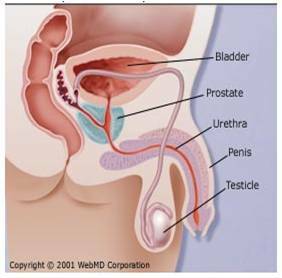
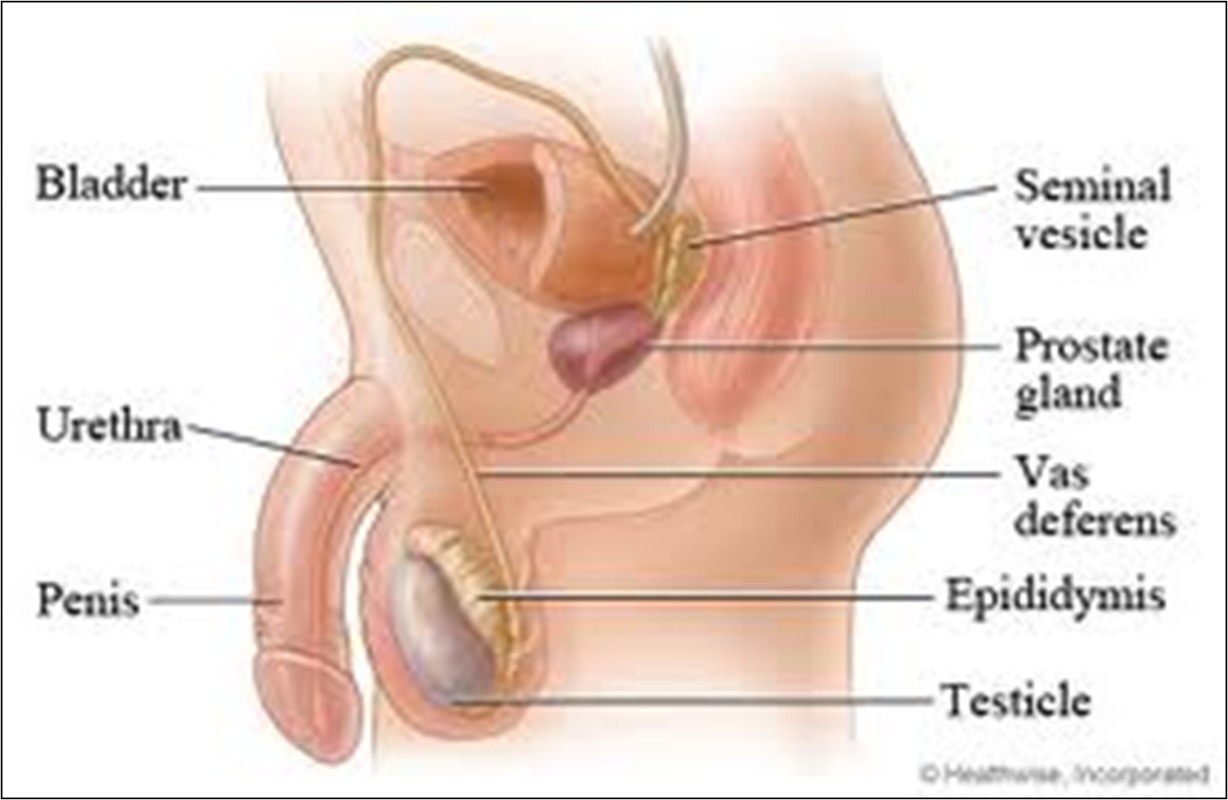
The male reproductive system consists of the following:
1. Testis:
• Each testis is a mass of numerous coiled tubes called semniferous tubules.
• Each is enclosed within a scrotal sac that suspends them between the thighs.
• This ensures that sperms are maintained at a temperature lower than that of the main body.
2. Seminiferous tubules
• The lining of seminiferous tubules consists of actively dividing cells which give rise to sperms.
• Between the seminiferous tubules are interstitial cells which produce the male hormones called androgens e.g. testosterone.
• The seminiferous tubules unite to form the epididymis, which is a coiled tube where sperms are stored temporarily.
• Vas deferens (sperm duct) is the tube through which sperms are carried from testis to urethra.
• Seminal vesicle produces an alkaline secretion which nourishes the spermatozoa.
3. Prostate gland
• Produces an alkaline secretion to neutralise vaginal fluids.
Cowpers' gland
• Secretes an alkaline fluid.
• All these fluids together with spermatozoa form semen.
4. Urethra
• Is a long tube through which the semen is conducted during copulation.
• It also removes urine from the bladder.
5. Penis
• Is an intro-mittent organ which is inserted into the vagina during copulation .
• is highly vascularised/spongy
• has a sensitive glands
• becomes erect to allow entry into the vagina
6. Scrotum
• contains the testes outside the body on whose walls the process of spermatogenesis takes place
• the process is favored by lower temperature
• it contains sertoli cells which nourish sperms until they are mature
7. Epididymis
• long and coiled for the purpose of sperm storage
8. Vas deferens
• muscular
• upon contraction pushes sperms out and allows ejaculation
Gametes
• produced in large numbers to increase chances of fertilization
• the sperms have a tail for swimming/large number of mitochondria to provide energy/allow swimming to reach the egg
9. Accessory glands
• are seminal vesicle, Cowper’s gland and prostate gland
• they produce seminal fluid to provide a medium/ nutrients for sperms to swim
Adaptation of the sperm to its function
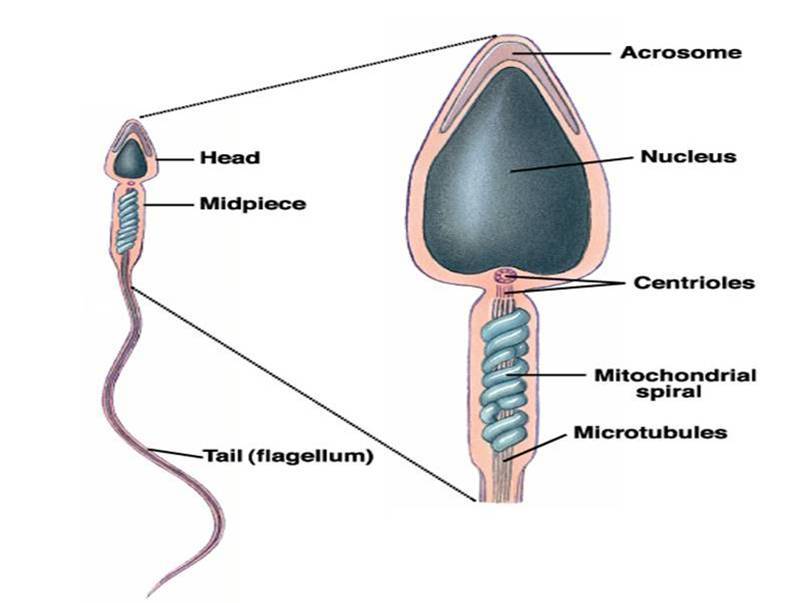
• Acrosomes contain enzymes to digest egg membrane
• Nucleus contains genetic material
• Mitochondria produce energy to move the tail back and forth
• The lashing movement of the tail enables the sperm to move/propulsion in fluid medium towards the egg
• It is streamlined for faster/easier movement/swimming to meet the egg.
Differences between sperm and ovum
| Sperm | Ovum |
| • long with a tail and head | • spherical |
| • small | • large |
| • locomotory | • stationary |
| • stores little food | • a lot of food stored in yolky cytoplasm |
| • has acrosome (tip with lytic enzymes) | • lacks acrosome |
| • nucleus prominent but cytoplasm negligible | • a lot of cytoplasm |
Fertilisation in Animals (Human)
• Fertilisation is preceded by copulation in which the erect penis is inserted into the vagina.
• This leads to ejaculation of semen.
• The sperms swim through the female's genital tract to the upper part of the oviduct.
• The head of the sperm penetrates the egg after the acrosome releases lytic enzymes t dissolve the egg membrane.
• The tail is left behind.
• Sperm nucleus fuses with that of the ovum and a zygote is formed.
• A fertilisation membrane forms around the zygote which prevents other sperms from penetrating the zygote.

Implantation:
• After fertilisation the zygote begins to divide mitotically as it moves towards the uterus.
• It becomes embedded in the wall of the uterus a process called implantation.
• By this time the zygote is a hollow ball of cells called blastocyst or embryo.
• In the uterus the embryo develops villi which project into uterus for nourishment later the villi and endometrium develop into placenta.
Embryonic membranes
• Embryonic membranes develop around the embryo.
• The outermost membrane is the chorion which forms the finger-like projections (chorionic villi) which supply nutrients to the embryo.
• The amnion surrounds the embryo forming a fluid filled cavity within which the embryo lies.
• Amniotic cavity is filled with amniotic fluid.
• This fluid acts as a shock absorber and protects the foetus against mechanical injury.
• It also regutates temperature.
• The chorionic villi, allantois together with the endometrium from the placenta.
• The embryo is attached to the placenta by a tube called umbilical cord which has umbilical vein and artery.
• The maternal blood in the placenta flows in the spaces lacuna and surrounds capillaries from umbilical vein and artery.
• The umbilical cord increase in length as the embryo develops.
Role of placenta
Protection
• Maternal blood and foetal blood do not mix.
• This ensures that the pathogens and toxins from maternal blood do not reach the foetus.
• The placenta allows maternal antibodies to pass into the foetus, providing the foetus with immunity.
Nutrition
• The placenta facilitates the transfer of nutrients from maternal blood to foetus.
Excretion
• Placenta facilitates the removal of nitrogenous wastes from the foetus' blood to maternal blood.
Gaseous exchange
• Oxygen from the maternal blood diffuses into the foetal blood while carbon (IV) oxide from foetal blood diffuses into maternal blood.
Production of hormones
• Placenta produces progesterone and oestrogen.
Gestation period
• The period between conception and birth is called gestation.
• In humans gestation takes nine months (40 weeks).
• The embryo differentiates into tissues and organs during this period.
Week 1 to 3:
• Zygote divides to form blastocyst.
• Implantation takes place.
• The three germ layers form endoderm, mesoderm and ectoderm.
• Nervous system starts to form.
Week 4 to 7:
• Development of circulating and digestive systems.
• Further development of nervous system, formation of sensory organs,
• All major internal organs are developed.
• At week 5, heartbeat starts.
Week 8 to 24:
• All organs well developed including sex organs.
• Hair, finger and toe nails grow.
• Foetus move and eyelids open.
Week 25- 30:
• The fully developed foetus responds to touch and noises and moves vigorously.
• The head turns and faces downwards ready for birth.
Week 31-40:
• Foetus increases in size.
• Birth occurs.
The events that take place to facilitate parturition
• Near birth the placenta produces less progesterone
• Oxytocin hormone is produced by posterior lobe of pituitary gland
because progesterone level has decreased, the uterus becomes sensitive to oxytocin
• oxytocin causes the contraction of the uterus (myometrium) these contractions are called labour pains,
just before parturition the head turns downwards
• The contractions eventually push the baby through the vagina
• Amnion breaks and amniotic fluid is released.
• Oxytocin dilates the cervix
• Foetus is expelled through cervix with head coming out first
• Finally the whole infant comes out
• The umbilical cord is cut and the placenta is expelled as afterbirth
Reproductive Hormones
| Hormone | Source | Function |
| Follicle Stimulating Hormone (FSH) |
Pituitary gland | Development of ovarian follicle; stimulates secretion of oestrogen by the ovary |
| Luteinising Hormone (LH) | Pituitary gland | Causes ovulation; causes development of Graafian follicle into the corpus luteurn; causes secretion of progesterone by the ovary |
| Prolactin | Pituitary gland | Initiates production and secretion of milk by the mammary glands |
| Oxytocin | Pituitary gland | Causes contraction of the uterus during parturition (birth) |
| Progesterone | Corpus luteum in the ovary |
Causes contraction of wall of the uterus to thicken after ovulation |
| Oestrogen | Ovary | Causes changes in the uterine wall in preparation for implantation; initiates development of secondary sexual characteristics |
| Androgens-Testosterone | Interstitial cells of testis |
Stimulates the development of secondary sexual characteristics |
| Interstitial Cell Stimulating Hormone (lCSH) |
Pituitary gland | Stimulates the interstitial cells of testis to release androgens |
| Human Chorionic Gonadotrophin (HCG) |
Chorionic villi | Stops the degeneration of the corpus luteum for production of oestrogen and progesterone |
Secondary Sexual Characteristics
Male
• Testerone is the main androgen that stimulates the development of secondary sexual characteristics.
• Broadening of the shoulders.
• Deepening of the voice due to enlargement of larynx.
• Hair at the pubic area, armpit and chin regions.
• Penis and testis enlarge and produce sperms.
• Body becomes more masculine.
Female
• Enlargement of mammary glands.
• Hair grows around pubic and armpit regions.
• Widening of the hips.
• Ovaries mature and start producing ova.
• Menstruation starts.
• Oestrogen triggers the onset of secondary sexual characteristics.
Sexually transmitted infections (STl)
| Disease | Causative agent | Method of transmission |
Symptoms | Prevention/control | |
| Gonorrhoea | Bacterium Neiseeria Gonorrhoea |
-Sexual contact - during birth for infants -Sharing towels |
-Itching of urethra -yellowish discharge pain as males urinate, vaginal Discharge. with odour in females |
A void indiscriminate sex. Treat both partners infected A void sharing linen |
|
| Syphilis | Bacterium Treponema Palladium |
-Sexual contact - During birth for Infants. - Sharing towels and linen |
Solitary painless ulcer-on genital or mucous -Rashes, muscles and papules on hands, feet lips, genital areas |
Treat at primary infection stage -Avoid indiscriminate Sex. - A void sharing linen |
|
| Trichomoniasis | Protozoan Trichomonas Vaginalis |
-Sexual contact -contaminated linen, underwear and toilet seats |
Itching of urethra or vagina in females, smelly, yellow discharge |
A void sharing linen -Avoid indiscriminate sex -personal hygiene |
|
| Hepatitis | Virus Hepatitis B |
-Sexual contact -blood transfusion - contaminated needles and syringes |
Fever, nausea, jaundice, loss of appetite, yellow urine |
-Avoid indiscriminate sex -use disposable needles and syringes - strict personal hygiene |
|
| Candidiasis | Fungus Candida Albicans |
-spread through sexual contact - sharing linen and towels |
ltching and burning sensation and white discharge from genitals |
-Avoid indiscriminate sex - Treat both partners |
|
| Herpes (Simplex) |
Virus Herpes Simplex |
-sexual contact kissing, contaminated needles |
Lesions on skin and mucous membranes of buccal cavity vagina or head of penis |
- A void indiscriminate sex and contaminated needles and syringes. |
|
| HIV and Aids | Virus Human Immuno Deficiency virus |
-sexual contact -blood transfusion -contaminated instruments -Through breast milk and body fluids. -Through birth canal for infants |
-chronic diarrhoea -weight loss (more than 10% body weight lost in a month) - constant, persistent cough, skin infectious (herpes zoster) |
-Avoid indiscriminate sex. -Use screened blood - No sharing of tooth brushes, razors - Use disposable needles |
Menstrual Cycle
• This is characterized by discharge of blood and tissue debris (menses) from the uterus every 28 days.
• This is due to the breakdown of the endometrium which occurs when the level of progesterone falls and the girl starts to menstruate.
• The follicle stimulating hormone (FSH) causes the Graafian follicle to develop and also stimulate the ovary to release oestrogen.
• Oestrogen hormone triggers the onset of secondary sexual characteristics.
• Luteinising hormone (L.H) causes the mature ovum to be released from the Graafian follicle - a process called ovulation.
• After ovulation progesterone hormone is produced.
• After menstruation, the anterior lobe of the pituitary gland starts secreting the follicle stimulating hormone (FS.H) which causes the Graafian follicle to develop in the ovary.
• It also stimulates the ovary tissues to secrete oestrogen.
• Oestrogen brings about the repair and healing of the inner lining of the uterus (endometrium) which had been destroyed during menstruation.
• Oestrogen level stimulates the pituitary gland to produce (Luteinising Hormone (L.H).
• This hormone makes the mature Graafian follicle to release the ovum into the funnel of oviduct, a process called ovulation.
• After releasing the ovum, the Graafian follicle changes into a yellow body called corpus luteum.
• The luteinising hormone stimulates the corpus luteum to secrete a hormone called progesterone which stimulates the thickening and vascularisation of endometrium.
• This prepares the uterine wall for implantation of the blastocyst.
• If fertilisation takes place, the level of progesterone increases and thus inhibits FSH from stimulating the maturation of another Graafian follicle.
• If fertilisation does not occur, the corpus luteum disintegrates and the level of progesterone goes down.
• The endometrium, sloughs off and menstruation occurs.
Advantages and disadvantages of each type of reproduction
• Good qualities from parents are retained in the offspring without variation.
• New individuals produced asexually mature faster.
• Process does not depend on external factors which may fail such as pollination.
• New individuals obtain nourishment from parent and so are able to survive temporarily under unsuitable conditions.
• No indiscriminate spreading of individuals which can result in wastage of offspring.
• Takes a shorter time and leads to rapid colonization.
Disadvantages of asexual reproduction
• New offspring may carry undesirable qualities from parents.
• Offspring may be unable to withstand changing environmental conditions.
• Faster maturity can cause overcrowding and stiff competition.
• Reduced strength and vigour of successive generations.
Advantages of sexual reproduction
• Leads to variations.
• Variations which are desirable often show hybrid vigour.
• High adaptability of individuals to changing environmental conditions.
• Variations provide a basis for evolutionary changes.
Disadvantages of sexual reproduction
• Fusion is difficult if two individuals are isolated.
• Some variations may have undesirable qualities.
• Population growth is slow.
Practical Activities
• About 2 mm of a root tip of onion bulb is cut off and placed on a microscope slide.
• A stain e.g. aceto-orcein is added and the root tip macerated using a scapel.
• A cover slip is added and observations made.
• Different stages of mitosis can be observed.
Examining the stages of meiosis
• An unopened bud of Tradescantia is obtained
• The anther is removed and placed on a microscope slide.
• A few drops of hydrochloric acid and acetic-orcein stain are added.
• A cover slip is placed on the anther.
• Pressing the cover slip gives a thin squash, which is observed under the microscope.
• Different stages of meiosis are observed.
To observe the structure of Rhizopus
• Rhizopus grow on moist bread left under suitable temperature
• A piece of moist bread is placed on a petri¬-dish or enclosed in a plastic bag and observe daily for four days.
• Under a low power microscope the sporangia and stolons can be observed.
To examine spores on sori of ferns
• Obtain the fern plant.
• Detach a frond from the plant and observe the under-side using a hand lens to see the raised brown patches - the sori.
• Open up the sorus to observe the sporangia.
Examine insect and wind pollinated flowers
• Obtain insect pollinated flowers e.g. crotalaria, hibiscus/Ipomea, Solanum, incunum.
• Note the scent, colour and nectar guides.
• A description of the calyx, corolla, androecium and gynoecium is made.
• Obtain a wmd pollinated flower e.g,' maize, star-grass, sugar-cane, Kikuyu grass.
• Observe the glumes, spikes and spikelet.
• Examine a single floret, and identify the androecium and gynoecium.
Classifying fruits
• Obtain different fruits - oranges, mangoes, maize, castor oil, bean pod, black jack .
• Observe the fruits, classify them into succulent, dry-dehiscent or indehiscent.
Dissection of Fruits
• Obtain an orange and a mango fruit.
• Make a transverse section.
• Observe the cut surface and draw and label the parts.
• Note that the fruit is differentiated into epicarp, mesocarp and endocarp.
• Obtain a pod of a legume.
• Open up the pod and observe the exposed surface.
• Draw and label the parts.
• Note that the fruit wall is not differentiated.
Dispersal of fruits and seeds
• Obtain animal dispersal fruits, like oranges, tomatoes, black jack, sodom apple.
• Identify the way by which each is adapted to dispersal by animals.
• Obtain wind dispersed fruit/seed
e.g. Nandi flame, Jacaranda Sonchus, cotton seed, Tecoma.